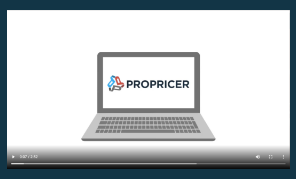No government contractor can run a successful business without understanding and adhering to the Federal Acquisition Regulation (FAR). The FAR is the primary source of regulatory truth for federal procurement, guiding both agencies and contractors through the entire competitive proposal and direct-procurement process.
Read on to explore FAR basics and delve into the various provisions and clauses you should know. We’ll also provide guidance on how to interpret and apply the FAR in the estimating process.
What the FAR brings to procurement
The FAR provides a comprehensive framework that standardizes the rules and procedures for acquiring goods and services on behalf of the U.S. government. Various entities within the federal government have developed the FAR over the years to ensure uniformity, consistency, and fairness in the federal procurement process. By following the FAR, government agencies and contractor firms like yours can more easily navigate the complex landscape of federal contracting, promote competition, and safeguard taxpayer dollars.
Key dimensions of the FAR
Some of the most important FAR basics to understand are the four key dimensions of this group of policies and procedures. The FAR lays out specific instructions for the solicitation and proposal process, costs and pricing, contract types, and subcontracting.
Solicitation and proposal process
The FAR outlines the requirements for requests for proposals (RFPs), including the information they must contain, evaluation criteria, and deadlines. Your firm should carefully review RFPs to understand the scope of work and proposal submission guidelines for each particular contract.
The FAR also defines the factors government agencies should use to evaluate proposals, such as contractor technical capabilities, past proposal performance, and history of innovative thinking throughout the contracting process. Your firm should align your proposals with these factors, and clearly demonstrate your ability to meet the government's requirements.
Costs and pricing
The FAR provides cost principles to guide contractors in developing and documenting their cost estimates. Your firm should understand these principles and ensure your proposals are in compliance so that you can avoid cost disallowances or audits.
According to the FAR, your firm must perform cost and price analyses to justify the reasonableness of your proposed costs and your proposed final pricing. Estimators should use historical data, market research, industry benchmarks, and other appropriate resources and techniques to support pricing decisions.
Contract types
The FAR lays out the terms and conditions for fixed-price contracts, in which the contractor agrees to deliver the product or service for a set price. Your firm must carefully consider the risks associated with fixed-price contracts and ensure your proposals reflect realistic cost estimates and pricing. Going either too high or too low can sabotage your efforts.
The FAR also addresses cost-reimbursement contracts, which stipulate that the contractor should be reimbursed for allowable costs incurred and receive a fee. Your firm should understand the specific provisions governing cost-reimbursement contracts and accurately estimate your costs to prevent overruns.
Subcontracting
The FAR requires contractors to develop and submit subcontracting plans that outline how they will involve small businesses, women-owned businesses, and minority-owned businesses in their contracts. Your firm should ensure compliance with these plans and actively seek qualified subcontractors in these categories.
Contractors must also understand the flow-down clauses included within their prime contracts. These clauses require the prime contractor to “waterfall” certain terms and conditions to their subcontractors. To maintain its contractual obligations, your firm must comply with these clauses.
Important provisions & clauses within the FAR
The FAR is divided into 53 parts, each covering a specific aspect of the acquisition process. For contracting firms like yours, one of the most important FAR basics is understanding the provisions and clauses that apply to your specific contract. Here are some of the essential ones to know:
- FAR Part 15 – Contracting by Negotiation. This part establishes the policies and procedures for conducting contract negotiations. It gives agencies guidance on how to prepare proposals and award contracts. It’s a great idea for you, as a contractor, to study how and why agencies will go back and forth on both pricing and costs with you so that you can gauge your submissions accordingly.
- FAR Part 31 – Contract Cost Principles and Procedures. This part instructs you on how to determine the allowable costs that can be charged to a government contract. It covers the different types of costs, such as direct and indirect costs, and establishes criteria for determining whether a cost is allowable.
- FAR Part 52 – Solicitation Provisions and Contract Clauses. This part contains the standard provisions and clauses you’ll find in most government contracts. It includes clauses related to contract performance, payment, warranties, and termination.
- FAR Part 36 – Construction and Architect-Engineer Contracts. This part gives agencies guidance on how to acquire construction and architect-engineer services. It covers the different types of contracts, such as fixed-price and cost-reimbursement contracts, and establishes the criteria for selecting contractors.
In addition to these provisions, the FAR includes numerous clauses that you’ll commonly see in government contracts. These clauses cover a wide range of topics, ranging from intellectual property rights to labor standards. Here are some of the most important clauses for your firm to know:
- The Termination for Convenience clause allows the government to terminate a contract at any time for any reason. This clause is designed to give the government flexibility in its procurement process—and it can pose a risk for your firm if you have already invested significant time and resources in a project.
- The Changes clause allows the government to make changes to the contract's terms and conditions. Can you adapt to changes in the government's requirements, which can sometimes be significant?
- The Disputes clause outlines the procedures for resolving disputes between the government and the contractor. This clause is designed to promote transparency and fairness in the contracting process.
- The Small Business Subcontracting clause requires large prime contractors to include small businesses in their subcontracting plans. This clause is designed to promote small-business participation in a larger purview of federal contracting.
- The Davis-Bacon Act clause requires contractors to pay prevailing wages to employees working on government contracts. This clause is designed to protect workers and ensures that no contractor can gain an unfair advantage by paying substandard wages.
Three ways to apply the FAR in your proposal & estimating process
It can be challenging to interpret and apply the FAR in the proposal and estimating process—but you have little choice. If your firm fails to apply the FAR correctly, you may lose contract awards or suffer other negative consequences. Here are three tips for interpreting and applying the FAR to your advantage:
- Read the solicitation carefully. A solicitation is a synonym for an RFP. It outlines the requirements for the contract, including the technical specifications, the cost and pricing requirements, and the proposal evaluation criteria. Make sure you read the solicitation carefully and verify that your proposal meets all the requirements outlined.
- Use standard proposal formats. The FAR provides standard proposal formats that contractors can use to make sure their proposals are compliant with the FAR. Using these can help ensure your proposal meets all the requirements outlined in the solicitation and that it is easily readable and understandable by the government.
- Use historical data. Historical data can be an invaluable resource when you are developing cost estimates. By using this data, you can gain insights into how similar contracts were priced in the past and develop a more accurate Basis of Estimate.
Meet the FAR’s cost & pricing requirements with ProPricer
Keep up with FAR basics by using the right software solution to handle your proposal process. ProPricer Contractor Edition is the industry-leading platform designed specifically for government contractor proposals. With it, your teams can increase the speed, accuracy, and quality of your firm’s proposal outputs.
The FAR places stringent requirements on the way your firm develops and documents its cost estimates and justifies the reasonableness of your proposed costs and pricing. ProPricer provides the support you need to meet these requirements.
It stores all your estimates, formulas, and qualitative information related to developing cost proposals. You gain real-time visibility into all your indirect and direct rates, and you can manipulate your data to customize your cost breakdowns and roll-ups.
Schedule a demo to learn how Contractor Edition can help you simplify FAR compliance and win more contracts. Contact us now.
Government Contracting Pricing Summit 2023: Achieving Pricing Excellence During Uncertain Times
Discover the latest trends in government contracting and learn from industry leaders at the upcoming Government Contract Pricing Summit. Attend fascinating keynote sessions, live-panel discussions, and intimate sessions on the latest FAR interpretations, cutting-edge contracting technologies, speed-to-contract methodologies, and more. Take advantage of this opportunity to expand your network and knowledge. Join us from June 20-22 in San Diego, CA. Register now to secure your spot.




